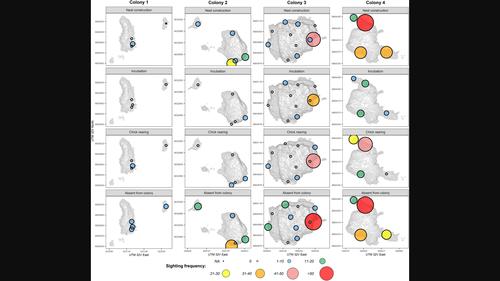Colony‐nesting gulls restrict activity levels of a native top carnivore during the breeding season
IF 3.9
2区 环境科学与生态学
Q1 ECOLOGY
引用次数: 0
Abstract
Although nesting in colonies can offer substantial reproductive benefits for many seabird species, increased visibility to predators remains a significant disadvantage for most colony‐breeders. To counteract this, some seabird species have evolved aggressive nest defense strategies to protect vulnerable eggs and chicks. Here, we used an experimental approach to test whether colony inhabitance by breeding gulls Larus spp. in western Norway impacts visitation rates of a native, mammalian predator, the Eurasian otter Lutra lutra during the breeding season. Camera traps were placed inside of and on the periphery of seabird colonies prior to the breeding season and left to run for one continuous year. Sighting frequency of otters on these cameras was compared to a control region free of gull nesting. We found that otter activity was significantly reduced in the colonies when gulls were incubating and rearing chicks, compared to time periods when gulls were building nests and absent from the colonies. Rhythmic activity patterns did not seem to be significantly impacted by the presence of gulls. This study provides clear evidence that certain colony‐nesting species can have a direct, negative impact on visitation rates of a native carnivore. Seasonal carnivore activity patterns are likely to be highly dependent on differing nesting strategies and level of nest defense by seabirds.

在繁殖季节,群体筑巢的海鸥限制了当地顶级食肉动物的活动水平
虽然在群体中筑巢可以为许多海鸟物种提供大量的繁殖优势,但对大多数群体繁殖者来说,增加对捕食者的可见度仍然是一个显着的劣势。为了对抗这种情况,一些海鸟物种进化出了积极的巢穴防御策略来保护脆弱的蛋和小鸡。在这里,我们使用了一种实验方法来测试在挪威西部繁殖海鸥的群体居住是否会影响当地哺乳动物捕食者欧亚水獭Lutra Lutra在繁殖季节的来访率。在繁殖季节之前,将相机陷阱放置在海鸟种群的内部和外围,并连续运行一年。在这些摄像机上看到水獭的频率与没有海鸥筑巢的控制区进行了比较。我们发现,与海鸥筑巢和离开群落的时期相比,在海鸥孵化和饲养雏鸟的时期,水獭的活动明显减少。有节奏的活动模式似乎没有受到海鸥存在的显著影响。这项研究提供了明确的证据,表明某些群体筑巢物种可以对本地食肉动物的来访率产生直接的负面影响。季节性食肉动物的活动模式可能高度依赖于不同的筑巢策略和海鸟的巢防御水平。
本文章由计算机程序翻译,如有差异,请以英文原文为准。
求助全文
约1分钟内获得全文
求助全文
来源期刊

Remote Sensing in Ecology and Conservation
Earth and Planetary Sciences-Computers in Earth Sciences
CiteScore
9.80
自引率
5.50%
发文量
69
审稿时长
18 weeks
期刊介绍:
emote Sensing in Ecology and Conservation provides a forum for rapid, peer-reviewed publication of novel, multidisciplinary research at the interface between remote sensing science and ecology and conservation. The journal prioritizes findings that advance the scientific basis of ecology and conservation, promoting the development of remote-sensing based methods relevant to the management of land use and biological systems at all levels, from populations and species to ecosystems and biomes. The journal defines remote sensing in its broadest sense, including data acquisition by hand-held and fixed ground-based sensors, such as camera traps and acoustic recorders, and sensors on airplanes and satellites. The intended journal’s audience includes ecologists, conservation scientists, policy makers, managers of terrestrial and aquatic systems, remote sensing scientists, and students.
Remote Sensing in Ecology and Conservation is a fully open access journal from Wiley and the Zoological Society of London. Remote sensing has enormous potential as to provide information on the state of, and pressures on, biological diversity and ecosystem services, at multiple spatial and temporal scales. This new publication provides a forum for multidisciplinary research in remote sensing science, ecological research and conservation science.
 求助内容:
求助内容: 应助结果提醒方式:
应助结果提醒方式:


